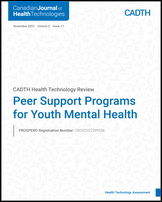|
Social withdrawal
Post-intervention: 84 (1 RCT
50
)
Longest follow-up: 84 (1 RCT
50
)
| One RCT50 with high risk of bias (unclear direction) reported on participants’ social withdrawal. This RCT50 compared the effectiveness of HOP program to treatment as usual among adolescent psychiatric patients, who were mostly were female (69.3%), born in Germany (94.8%) and were around 22 months since the first psychiatric diagnosis. The outcome was assessed by the stigma-coping and orientation subscale of the Link’s Stigma Scales55 (7 items related to withdrawal). Higher mean scores (range 1 to 6) indicate more secrecy.50 The results of the trial suggested that peer support may be favoured compared to treatment as usual on lowering the participants’ social withdrawal at post-treatment. However, the effect was small (mean between-group difference for change from baseline = 0.34 [95% CI –0.63 to –0.05]), and the clinical importance is unclear. At 6 weeks post-intervention, there was no significant difference between the groups in the change form baseline of mean scores. |
Very low
due to serious concerns for risk of bias, concerns for inconsistency, serious concerns for indirectness and imprecision.a
| HOP may be favoured vs. TAU with respects to social withdrawal at post-intervention, but the evidence is very uncertain. There may be little to no difference in the effect of HOP vs. TAU on feeling of empowerment at follow-up, but the evidence is very uncertain. |
